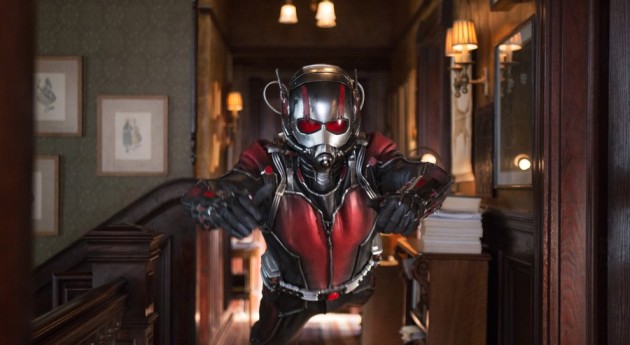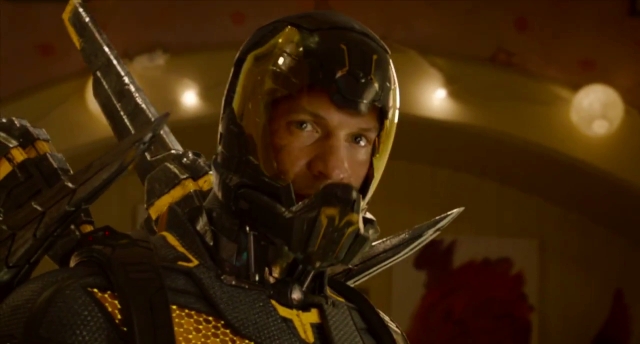Ant-Man is the riskiest studio bet of the year. Did its rocky development process ultimately doom it? Or did the little superhero film that could pull off a cinematic miracle?
Genre: Action/Heist/Super-hero
Premise: A high-profile burglar is recruited by a famous scientist to break into his old company utilizing a cutting-edge shrinking technology.
About: When newly-formed Marvel Studios came up with their game plan (create an interconnected universe of movies just like they’d done with their comic books), Hollywood laughed. And why wouldn’t they? The town is infamous for ignoring any model outside of the ones they’ve carefully cultivated themselves. Boy were they thrown when the prodco then rode their model to become the most successful in the business. But even the biggest Marvel supporters did a double George Takei when the caped company announced they’d be making a film about Ant-Man. The character seemed to embody the opposite of what made super-hero characters so cool (being big, strong, having powers, not talking to ants). So putting 130 million dollars into a super-hero version of “Honey, I Shrunk the Kids,” seemed about as smart as casting Rick Moranis as Thor. Complicating the matter even further, geek superstar director Edgar Wright (Shaun of the Dead, Scott Pilgrim vs. The World), who had been developing the movie for ten years, was axed by Marvel Don, Kevin Feige, at the last second. Rumors were that Wright’s vision of the story was too weird and wouldn’t fit into the Marvel universe. He was replaced by a director with only slightly more notoriety than your average craft services table – Payton Reed. This coincided with comedy writer Adam McKay (Step-Brothers, Anchorman) coming in to rewrite the script with the star of the film, Paul Rudd. All of a sudden, the industry wondered whether Will Ferrell would be playing the film’s villain, More Cowbell. While the movie didn’t do typical Marvel-like numbers, it made a respectable 57 million dollars this weekend, and introduced the world to one of the more unique super-heroes in Marvel’s antsenal.
Writers: Edgar Wright & Joe Cornish and Adam McKay & Paul Rudd. Story by Edgar Wright & Joe Cornish. Based on the comic book character created by Stan Lee & Larry Lieber & Jack Kirby
Details: 110 minutes
Ant-Man may seem like a tiny movie in the grand scheme of things, but there’s actually a lot to learn from the film and its much-publicized development. The biggest thing I took away from it was how hard it is to do something different in this business.
As I’ve been saying for awhile now, if superhero movies are going to survive, they’ll need to evolve. We’re getting to the point where a new super-hero film is coming out every month. It’s only a matter of time before the Marvel methane bubble bursts.
That’s why Feige is introducing a character like Ant-Man. It’s why DC decided to make Suicide Squad. It’s why we’re getting a foul-mouthed vigilante super-hero in Deadpool. It’s why Warners feels they need to put both of their prime-time super-heroes in the same movie. “Different” may be the only way to survive in this oversaturated market.
But watching the delusional development of Ant-Man go down proves just how terrified Hollywood is of “different.” They said to themselves, “We already have a super-hero who’s different. Do we want a director who’s different too? Wouldn’t that make things… too different?” So they got rid of Edgar Wright and brought in the most vanilla director this side of an oversized teaspoon.
What was the result? Well, a pretty vanilla movie. A lot of safe choices. A lot of film school 101 shots (oh, here comes that establishing crane shot that starts 1 story high then cranes down to street level just as the car door opens and our hero gets out!).
But what’s interesting about Ant-Man is that it still contains echoes of Wright’s original vision. So we get these moments of divine inspiration that seem like they belong in a different movie. And that’s because they’re from a different movie – the movie the previous director wrote. I mean, I’d be very surprised if Reed had anything to do with the kid’s train set action piece in the film’s climax.
So what’s Ant-Man about? Glad you asked. An old scientist named Hank Pym, who used to run one of the biggest companies in the world, becomes concerned when his successor, the potentially crazy Darren Cross, shifts all the company resources into creating shrunk-down super-soldiers who can infiltrate enemy lines without being noticed.
Little does Cross know, Pym figured out how to do this 50 years ago, and already has one of these super-soldier suits, which allows whoever wears it to shrink down to the size of an ant. Fearing Cross will use the technology for evil, Pym recruits local burglar Scott Lang to wear his suit, sneak into his old company, and steal Cross’s prototype suit, a jacked-up version of the Ant-Man suit code-named “Yellow-Jacket.”
Lang trains with Pym and his hot daughter, Hope, who happens to work with Cross. There’s some sexual tension there. We learn that Pym and his daughter have a strained relationship. Oh, and let’s not forget that Lang learns how to work with and control different species of ants to aid him in his heist. In the end, Cross catches on to what’s happening, hops into the Yellow Jacket suit, and the two micro-battle their way to a sub-atomic climax, which is the same way most of my sexual exploits end.
While the execution is freakishly vanilla-extract throughout the bake sale that is Ant-Man, there are a few lessons to learn here. For starters, in the blockbuster world, you want to try and find ideas that allow you to do things that haven’t been done before.
Having super-hero battles take place on a living room rug is a very unique set-up. We haven’t seen that before and it allows you to try things that haven’t been done in this genre. This doesn’t apply exclusively to super-hero movies either. You should be looking to do this with any movie idea.
And often that opportunity is right under your nose. That’s because people see genres the way they’ve always been, not the way they could be. When I say “super-hero movie,” you probably think capes and large city battles, right? Why? Why can’t a super hero battle take place inside the hard drive of a desktop computer?
Your job, as a writer, is to look to the future, not the past. Find the angle that makes a well-established genre fresh. People were making the same freaking Godzilla movie for 40 years until someone decided to tell the story from a hand-held camera POV (Cloverfield). That fresh new angle is there for the taking. Take it!
Next up, super-hero movies don’t have an official format outside of maybe “origin movie.” But origin stories have become so standard, audiences are bored with them. For this reason, you want to look for a genre within the genre.
Ant-Man’s smartest decision was becoming a heist film (one of Wright’s ideas). Once you have a genre, you can go back through all the other movies that have operated in that genre, see how they did it, and use their structure as a blueprint for your own movie.
This is the same thing the insanely popular “Captain America: Winter Soldier” did. They made that movie a conspiracy thriller. This allowed them to go back to movies like “Three Days of The Condor,” see how they made them work, then use the same principles to make their film work.
If you don’t have a genre to guide your movie, you’re flying blind. You’re making up shit as go along and hoping it works. Every once in a long while, someone pulls off a miracle, but usually if you don’t have that blueprint to guide you, you crash and burn.
Finally, commit. It doesn’t matter what kind of story you’re telling. If you don’t commit to it 100%, it’s not going to work. Ant-Man is, in a lot of ways, a ridiculous idea. I mean, Scott Lang chums it up with ants and trains them to help him execute a heist. But you know what? That’s the story you chose to tell. If you’re scared to tell that story? If you dance around it? The script will never work. So you gotta commit. And they did.
And that goes for ANY idea. When I read “Bubbles,” the script about Michael Jackson told through the eyes of his chimpanzee – that script doesn’t work if the writer thinks his idea is too weird and decides, midway through, to switch the point of view over to Jackson. This is your premise. Embrace it 100%. That’s the only way a weird idea works.
And you know what? That commitment is what led to Ant-Man’s best scene, the showdown between Ant-Man and Yellow-Jacket in a child’s bedroom. A writer who was scared of this idea surely would’ve looked for a “cooler” place for Ant-Man and Yellow-Jacket to fight. Maybe in one of those industrial warehouses we never ever see in action movies (note to all: this is sarcasm. There is nothing Carson hates more than action movies that end in industrial warehouse locations). So despite many of Ant-Man’s faults, I have to give them credit for fully committing to the idea.
To sum up, I’m really torn on this movie. On the one hand, I’m so happy that Marvel took a chance and tried something different. On the other, I’m disappointed they neutralized that choice by going with such a vanilla director. I mean, this appeared to be shot with the same lens package and character blocking that gave us Reed’s, “The Break-Up.” And I’m not saying Wright would’ve saved this. In reality, he probably would’ve made it too weird. But this movie needed a director (and writers) better than the ones it got. It was okay. But it could’ve been so much better.
[ ] what the hell did I just watch?
[ ] wasn’t for me
[x] worth the price of a matinee ticket
[ ] impressive
[ ] genius
What I learned: Embrace the movie you’re trying to write no matter how strange it is. If you’re scared of it, if you try and give us the sanitized version of it, the audience will feel let down. Imagine Eternal Sunshine of the Spotless Mind without the beach house crumbling around our characters. Life of PI without the tiger on the boat. Inside Out is a wonderful example of how to do a weird/unique idea right. It committed to an extremely complicated working model of the mind that included physical embodiments of feelings, memory balls, islands of happiness. I mean they went ALL IN. In general, when you’re writing something weird, anytime you put something down on the page that could be considered “safe,” press delete, go back, and give us the more daring version.



